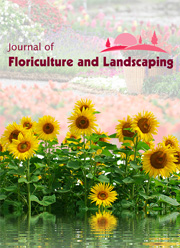Performance of foliage ornamentals in hydroponic nutrient solutions
DOI:
https://doi.org/10.25081/jfcls.2020.v6.5753Keywords:
Hydroponics, nutrient solution, foliage ornamentalsAbstract
Vertical garden is one of the approach of green building envelope with green facades and green living walls creates a richer ecosystem, enhances biodiversity, improves mental health, alleviates environmental externalization generated by urban areas (Pollution, runoff and heat island effect etc). However, the limitations of vertical gardening system are the choice of plants and the module of growing. Numerous exotic and native ornamentals are suggested for vertical systems based on the requirements. Selection of plants grown under indoor environments with limited space is narrowing down the choice of ornamental flora. On the other hand hydroponics is an alternative sustainable production system under conditions in which resources are limited. Hydroponics is a very young science which has commercial basis during recent days. However, even in relative short period of time it has been adapted in many situations from outdoor to indoor for growing various crops. Hence, an experiment was conducted with Hoagland & Arnon solution (1938), Cooper’s solution (1979), Saparamadu’s solution (2010) and Mattson and Peters solution (2014) and a control with Irrigation water to study the rooting behavior of five plants viz., Devil’s ivy (Epipremunm aureum), Wandering jew (Zebrina pendula), Arrowhead plant (Syngonium podophyllum), Philodendron (Philodendron erubescens), Boat lily (Tradescantia spathacea) under passive hydroponic vertical garden module. The pH was monitored for acidity and basicity range and EC were monitored for salt concentration in all the nutrient solution periodically. Observation on root parameters viz., Number of roots plant -1, Root length (cm) and Root weight (g plant-1) were observed at 30, 60 and 90 days after planting. Results of the experiment revealed that number of roots, root length and root weight exerted maximum values in those plants grown under T3 (Cooper’s solution). Minimum rooting with lowest weight was recorded in T4 (Saparamadu solution) in all the stages of observation in devil’s ivy. Whereas in other four ornamentals viz., Wandering jew (Zebrina pendula), Arrowhead plant (Syngonium podophyllum), Philodendron (Philodendron erubescens) and Boat lily (Tradescantia spathacea) recorded lowest root parameters in T1 (Irrigation water) under 30 days of observation and at 60 and 90 days minimum number of roots, root length and root weight was recorded under T4 (Saparamadu solution).
Downloads
References
Cooper, A. 1979. The ABC of NFT. Nutrient film technique. The world’s first methods of crop production without a solid rooting medium. Grower books.
Gruda, N. 2009. Do soilless culture systems have an influence on product quality of vegtables? Journal of Applied Botany and Food Quality, 82: 141-147.
Hoagland, D. R. and Arnon, D 1938. Growing plants without soil by the water- culture method, Circ. California Agricultural Experimental Station, 347
Keat, C. K. and Kannan, C. 2015. Development of a cylindrical hydroponics system for vertical farming. Journal of Agricultural Science and Technology, 5: 93-100.
Kilinc, S. S., Ertan,E. and Seferglu,S. 2007. Effect of different nutrient solution formulations on morphological and biochemical characteristics of nursery fig tree grown in substrate culture. Scientific Horticulture, 113(1): 20-27.
Li, H. and Cheng, Z. 2014. Hoagland nutrient solution promotes the growth of cucumber seedling under light-emitting diode light. Acta Agri. Scandinavica, 65(1): 74-82.
Mattson, N. S. and Peters, C. 2014. A recipe for hydroponic success. http://www.greenhouse.corenell.edu/crops/factsheets/hydroponic-recipes.pdf p.16-19
Nemali, K. S. and Van Iersel, M.W.. 2004. Light Intensity and Fertilizer Concentration: I. Estimating Optimal Fertilizer Concentration from Water-Use Efficiency of Wax Begonia. Horticultural Science, 39(6): 1287-1292.
Resh, H. M. 2004. Hydroponic Food Production: A Definitive Guidebook for the Advanced Home Gardener and the Commercial Hydroponic Grower. CRC Press, New Jersey.
Samarakoon, U., Weerasinghe, P. and Weerakoddy, W. 2006. Effect of electrical conductivity (EC) of the nutrient solution on uptake, growth and yield of leaf lettuce (Lettuce sativa L.) in stationary culture. Tropopical Agricultural Research, V ol. 18.
Saparamadu, J. S., Wijesekera, R.D., Gunawardhana, H.D. and Weerakkody,W. 2010. A low cost nutrient formulation with a buffer for simplified hydroponics systems. Journal of Horticulture and Forestry, 2(5): 99-103.
Sonneveld, C. and Voogt, W. 2009. Nutrient management in substrate systems. Plant nutrition of green house crops. Springer, 277-312.



 .
.